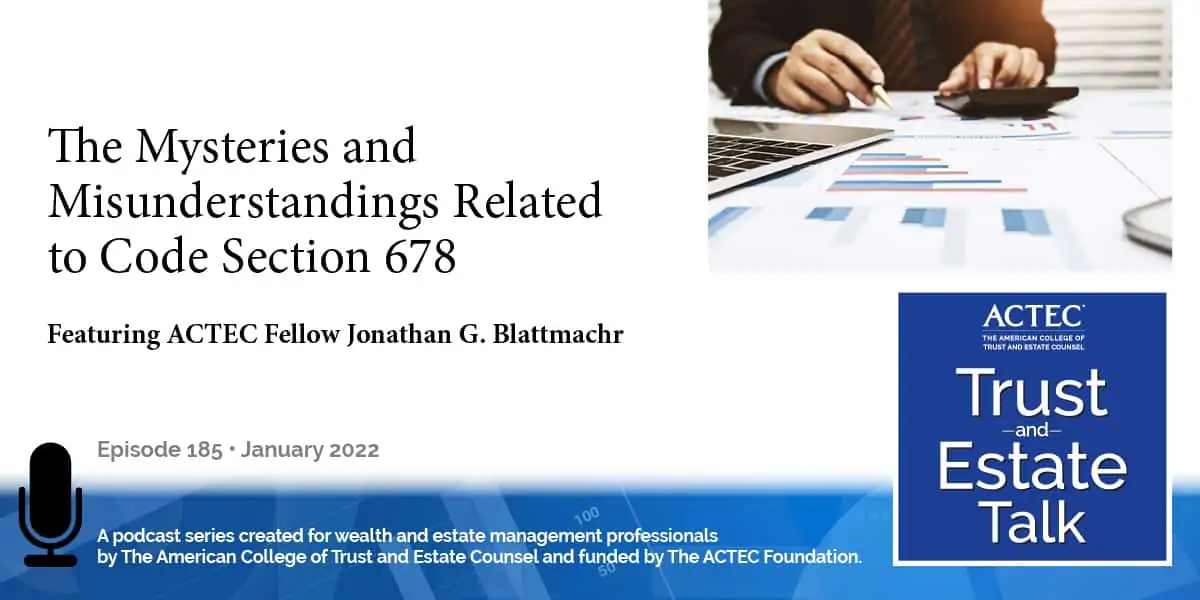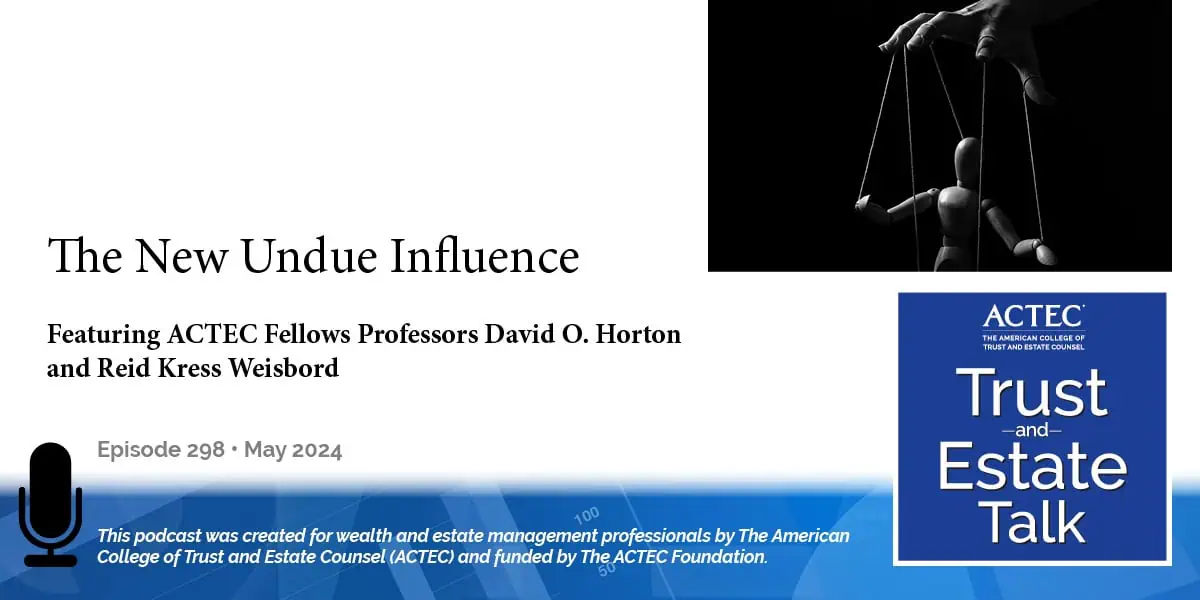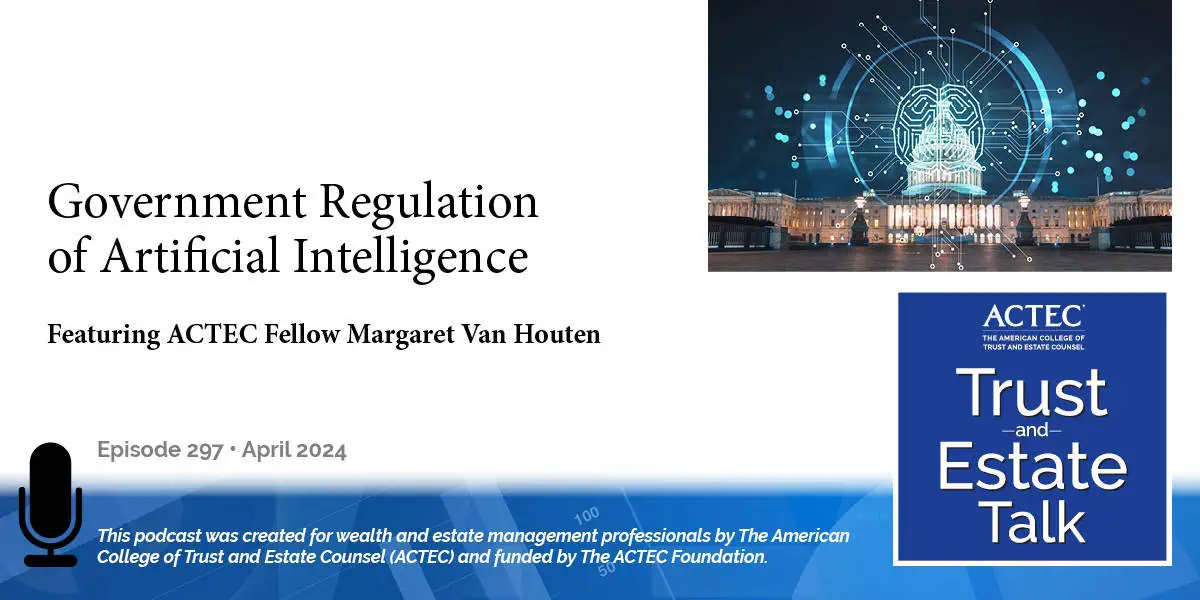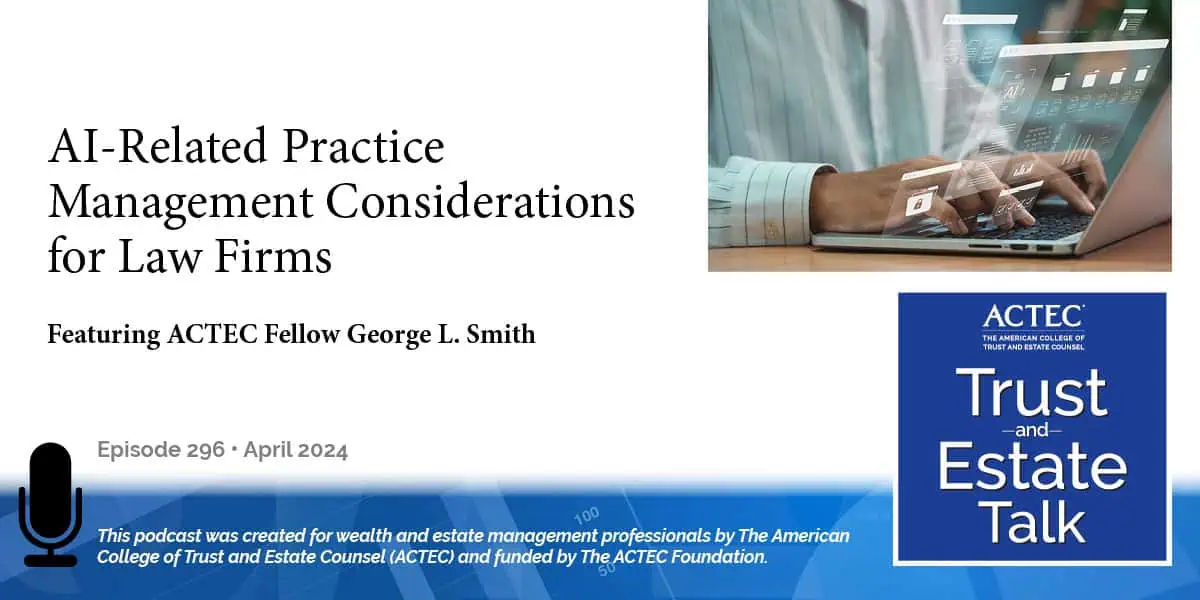The Mysteries and Misunderstandings Related to Code Section 678

“Mysteries and Misunderstandings Related to Code Section 678,” that’s the subject of today’s ACTEC Trusts and Estate Talk.
Transcript/Show Notes
This is Susan Snyder, ACTEC Fellow from Chicago. In November of 2021, we shared a podcast entitled, Traps Awaiting Beneficiary-Owned Trusts Under Section 678. Today, we will continue that discussion with ACTEC Fellow Jonathan Blattmachr of New York City, who will share more mysteries related to Section 678 and beneficiary owned trusts. Welcome, Jonathan.
Understanding Beneficiary-Owned Trusts and Section 678
Well, thank you very much, Susan, I appreciate it. It’s an honor for me to be able to talk about a really important topic, which is Section 678. As you know from the prior lecture, 678 is a trust which has its income, deductions, and credits against tax directly attributed to the beneficiary as though the beneficiary had directly received the income, deductions, or was entitled to the credit. And we need to know about Section 678 for two reasons.
First, it could come as a very unpleasant surprise to a trust beneficiary who is in the process of doing planning or setting up certain planning things to find out that because income has been imputed to her, the planning is going to be trust rated or not as good as it could have been. A similar case is where the beneficiary is subject to state income tax but the trust would not be. So, by having the income attributed directly to the beneficiary, we’re now going to have to pay state income tax. In some states, like New York and California and Oregon and New Jersey, we face very, very high state income taxes. So, that’s not a very good thing to happen. Also, increasing the income of a beneficiary may mean their tax profile has changed and that could be for better or it could be for worse, but we need to be aware that that income is going to be imputed so we can do proper planning.
On the other hand, there are cases where we want the income to be imputed directly to the beneficiary, such as where the trust would face much higher income tax than would the beneficiary. A trust may reach the top income tax bracket at just a little over $12,000, but individuals almost never face that top rate until they have over $500,000 in income. And the consequences of taxation to a trust may be compounded or made worse if proposals in the Congress to impose surcharges are enacted. Although individuals generally won’t face surcharges until their income is in excess of $10 million a year, a trust will face that surcharge if the income is over $200,000 a year.
Types of Trusts
Now, basically there are two types of trusts for income tax purposes under federal law: grantor trusts and non-grantor trusts. Actually, and I think most people don’t know this, the Internal Revenue Code doesn’t use the term grantor trust. It talks about a deemed owner trust. And that’s because if the trust is a grantor trust, someone is deemed to own the trust and its assets. The basic consequence of being a grantor trust is that under Section 671, as I stated a little earlier, the income, deductions, and credits against tax are attributed to the owner, who typically is the grantor. But Section 678 imputes it to another owner.
Now, grantor trusts were developed by the Treasury, not the Congress. And the Treasury did that by the issuance of regulations under the 1939 Code, and even I wasn’t born when these came out, or maybe I had been just born. The regulations were issued to curb the ability of a taxpayer to be able to divide or split income with another taxpayer. And up until 1986, trusts essentially had the same runup in the income tax brackets as did individuals. Therefore, by dividing income with the trust meant overall income taxation was reduced and with more and more trusts, there could be a further shifting of income and a further reduction in income taxation.
The Current Complexities
But today, of course, grantor trusts are generally good, and they allow us to engage in what is sometimes very efficient lifetime estate planning, including installment sales to grantor trusts of appreciated assets without income recognition, and, most powerful of all, having the grantor pay the income tax on the income earned by the trust, which allows the trust to earn its income on a tax-free compounded basis, perhaps the most powerful thing in all of building wealth.
The grantor trust rules are very complicated, and they’re not at all intuitive. Not only are the provisions themselves very complicated, but they have different rules for income of a trust, and here I mean income in a trust accounting sense. And different rules, in some cases, for a corpus in a trust accounting sense. And all of this is further complicated because a trust can be a partial grantor trust or deemed owner trust.
Although, as I stated earlier, the income deductions and credits to the trust are attributed to its owner, typically the grantor. Hence, that’s why they are called grantor trusts, although again, the Code doesn’t use that phrase. In one case, they’re attributed to a beneficiary who is not the grantor, and that’s set up for us in Section 678.
And that kind of trust is sometimes called simply a 678 trust or a beneficiary grantor trust, although the beneficiary is not the grantor or a beneficiary defective trust, or a BDIT, referred by most people as a “BDIT.”
Conditions of 678 Trust – BDIT
A 678 trust, the provisions are kind of short. To be a BDIT, a 678 trust, two conditions must initially be met. First, it can’t be a regular grantor trust to anyone. And a common mistake that I’ve seen made a number of times when someone is trying to form a BDIT or a 678 trust, is to put in a provision that would make it a grantor trust as to the trust grantor, such as the power to substitute property of equivalent value, which under Section 675(4)(C), causes it to fall under Section 671 and be a deemed owner, or grantor trust.
If you do that, if you put in a provision that would make it a “regular grantor trust” by giving someone the so-called swap power, or a power to substitute property, then you can’t have it be a BDIT. The reason is, is that the regular trans-grantor trust rules under Section 678(b) tell us that if you have a regular grantor trust, it can’t be a BDIT.
Now, there is one PLR where the IRS got it wrong, but it’s just wrong. If you put in a power of substitution, if you put in certain powers to borrow, you put in powers held by certain related people, or the grantor’s spouse has certain powers, that’s going to make it a grantor trust with respect to the real grantor- the person who put the money in the trust. And you can’t have a BDIT.
So, even if you keep it from a regular grantor trust, which is the first condition to fall under 678. It will only be a BDIT if the trust meets a second condition. What that second condition is, is that someone other than the grantor or the grantor’s spouse has the power solely exercisable by herself to vest the corpus or the income of the trust in herself.
Now, some people think that this means that you give the beneficiary the right to withdraw for an ascertainable standard- like you authorize the beneficiary to withdraw for her health, education, maintenance, or support- that you will have a 678 trust. And people think they’re so clever in doing that because they know that if the beneficiary can only withdraw property for that health, education, maintenance, or support standard, the so-called HEMS standards, that’s not a general power of appointment. So, it won’t cause the trust to be includable in the beneficiary’s estate. So, they think this is absolutely magnificent because you have the beneficiary pick up the income and it won’t be in her estate and all of that is absolutely fantastic. So, you get the ability to have that trust grow also income-tax free. But case law establishes, and you can read it tonight with your family in that article by Mitch Gans, Alvina Lo, and me in the ACTEC Journal (A Beneficiary as Trust Owner: Decoding Section 678.). And I’m telling you, it is an exciting read, which will explain that giving someone a HEMS power won’t work. The cases make it clear it’s only to the extent the beneficiary can unilaterally take property out that it’s going to be imputed to the beneficiary. So, there you have it.
Now, the unilateral power to withdraw sometimes goes away. For example, you’ve all seen Crummey Trusts, where you give someone the right to withdraw property from the trust, and then it disappears, it lapses. Well, Section 678(a)(2) says it will continue to be a BDIT, a 678 trust, even if the power goes away if the power holder has previously- and please pay close attention to these words- the power holder has previously partially released both of those words that we’re going to discuss as important, have partially released or otherwise modified the power and after the release or modification contain such control as would cause it to be a regular grantor trust.
So, if you can get yourself to a position where you believe you have a partial release or a modification which falls under 678, it’s still got to be a grantor trust with respect to the beneficiary. You can’t do it by a power of substitution because that will make it a grantor trust with respect to the real grantor, which is going to pull a close of the application of Section 678. The way you handle it is you authorize an independent fiduciary to be able to make a distribution to the beneficiary.
Understanding Partially Released
Now, you noticed I emphasized the words “partially released.” One law firm has taken the position that the lapse of the power is the same as a release. Now, the reason they want that is because a lapse can be an entirely gift and estate tax nonevent. For example, under Section 2041 and 2514, which deal with general powers of appointment, those sections say that a lapse, just the disappearance on its own, is treated as a release only to the extent it exceeds 5% or $5,000 that’s in the trust.
Now, those five and five rules contained in Section 2514 and 2041 predate Section 678. So, if Congress wanted a lapse to be treated as release, it certainly knew about that, and it certainly knew how to say that, but it didn’t. And I therefore think it is risky to contend that a lapse is a release. I appreciate the IRS has not come after people, but we also know from some issuance from the federal government that it’s not terribly pleased about so-called beneficiary defective trusts, or BDIT.
Now, the second part relates to “partially release.” Even assuming a lapse is a release, and I really question whether it is, I don’t see how a total lapse is a partial release. Now, there are several private letter rulings that indicate that a total lapse is a partial release for purposes of 678, but they never expressly state so. They indicate it but they don’t say so. And even if they did, they are only private letter rulings and we cannot cite or use private letter rulings as precedent.
Alternate Approach with a BDOT
Now, some of you have heard something about a BDOT, B-D-O-T. The thought here is that we can make a trust a complete 678 trust without giving the beneficiary the right to withdraw everything in the trust, just the taxable income. So, that means we can stuff a tremendous amount of property into that trust and not have to worry about limiting to a 5% or $5,000 lapse. It’s a very clever idea if it works.
This could mean, for example, that a parent could create a trust for a child, giving the child the right to withdraw all tax income, which the theory goes on to say, it’s a 678 trust in its entirety. So, for example, the child could sell appreciated assets to the trust without gain. Well, let’s test that a little bit. First, and you might want to write this down, Reg 1.671-3(a)(1). Let me give that to you again, 1.671-3(a)(1) says basically when the grantor or another person is the owner of any portion of the trust, they’re included in his taxable income those items of deduction, income, and credit that are attributable to that portion. And it goes on to say, for example, if a grantor or another person, and now we’re talking about a beneficiary, is treated as the owner of the entire trust, corpus as well as ordinary income, he takes into account in computing his taxable income all items of income, deductions, and credits for which he would have been entitled had the trust not been in existence. This to me suggests that maybe you can’t have a trust treated as an entire grantor trust or deemed owned trust unless you can take not just the taxed income, but the corpus as well. So, that’s a serious issue.
But there’s another issue. Very often, a taxpayer – this has probably happened to everybody on the phone – has had imputed income, such as where income is imputed from a partnership. You’re a partner in a law firm, you get imputed income. You don’t necessarily receive that income until long after the taxable income has been imputed. And that happens with trusts.
So, to the extent the trust has imputed income, but not in hand, and if you’re investing in a partnership, if you have an S-corporation, you’re going to have imputed income, and it will not necessarily be received. If it’s not received by the trust, the beneficiary can’t take it out. And under the Sid Richardson case, decided many, many years ago by the Fifth Circuit, it appears if you can’t take it out, you’re not going to be treated as though you’ve got it.
Final Thoughts
One final thought. If a trust requires that income be distributed to a beneficiary or gives the beneficiary the right to all the income, in an accounting sense, as in the case of a marital deduction trust, is it a 678 trust? No. The regs say that the mere entitlement to all accounting income from a trust will not make it a grantor trust, even as to the income element.
So, now we know a little bit more about Section 678 trusts. They can be good; they can be bad, but we need to know about it. Thank you very much for having me.
Thank you, Jonathan, and thanks for explaining the uses of Section 678 and BDITs for very powerful tax planning.
You may also be interested in:
This podcast was produced by The American College of Trust and Estate Counsel, ACTEC. Listeners, including professionals, should under no circumstances rely upon this information as a substitute for their own research or for obtaining specific legal or tax advice from their own counsel. The material in this podcast is for information purposes only and is not intended to and should not be treated as legal advice or tax advice. The views expressed are those of speakers as of the date noted and not necessarily those of ACTEC or any speaker’s employer or firm. The information, opinions, and recommendations presented in this Podcast are for general information only and any reliance on the information provided in this Podcast is done at your own risk. The entire contents and design of this Podcast, are the property of ACTEC, or used by ACTEC with permission, and are protected under U.S. and international copyright and trademark laws. Except as otherwise provided herein, users of this Podcast may save and use information contained in the Podcast only for personal or other non-commercial, educational purposes. No other use, including, without limitation, reproduction, retransmission or editing, of this Podcast may be made without the prior written permission of The American College of Trust and Estate Counsel.
If you have ideas for a future ACTEC Trust & Estate Talk topic, please contact us at ACTECpodcast@ACTEC.org.
© 2018 – 2024 The American College of Trust and Estate Counsel. All rights reserved.
Latest ACTEC Trust and Estate Talk Podcasts

The New Undue Influence
Law professors discuss the evolving landscape of undue influence in estate law, analyzing economic dynamics, legislative changes, and empirical findings.

Government Regulation of Artificial Intelligence
Rapid growth of AI demands government regulation to safeguard against misuse of private data. Global efforts are underway to address this critical issue.

AI-Related Practice Management Considerations for Law Firms
A discussion for law firms about how to incorporate AI in their practice management, including staff considerations, the “billable hour,” and more.

